Caribbean, Part I – If it’s Monday it must be Martinique
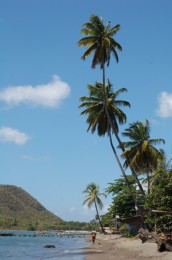
The Caribbean. To the land-dweller, cocooned in his bricks and mortar, the name probably means a brief escape. It conjures up images of white beaches lined with coconut palms and lapped by turquoise waters. Honeymoon couples come here, breaking out of their old routine like butterflies released into a new but very brief life of colour and freedom. Traversing the sky at impossible height and speed, they enjoy a fortnight in paradise. And then they hop back into the jumbo, and hurtle back through time and space, to resume the steady munch and crawl of everyday existence; to take up residence in their old familiar nest.
To the cruising sailor, carried along like the paper nautilus in his floating shell, the Caribbean means something more than a holiday, for we have already escaped from suburbia, TV, Tescos, and the tarmac-ed rut. But if the world is the sailor’s oyster, the Caribbean is probably the pearl, for no other place throughout the seven seas seems so perfectly designed to meet our requirements. Here, laid out for our enjoyment, is a long necklace of beautiful islands, each one conveniently spaced about a day’s sail from the next. The whole area is bathed in perpetual sunshine and – throughout the winter, at any rate – is caressed by a reliable wind of the ideal strength and the perfect direction. Like a conveyor belt, it stands ready to woosh us north or south, all the way from Trinidad right up to the Bahamas.
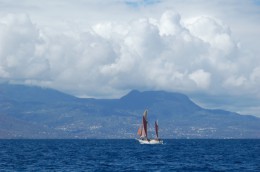
Could this dream-playground really have erupted onto the surface of the planet by chance? Surely not. Indeed, it probably represents the surest proof of Intelligent Design. God evidently must have employed a cruising man for this part of his project. With the sailor’s blue-print in his almighty hand the creator strung the jewels across the mouth of the Caribbean Sea, switched on the heater and the big fan, and created the ultimate theme park for sailors.
But they say that even in Heaven there are nettles growing, and certainly no earthly paradise is without its flaw. At Eden Waterworld the drawback takes the form of the hurricanes which threaten the area in the northern summer.
From the point of view of this particular bunch of sailors, the threat of those ill winds was actually something of a saving grace. We Mollymawks are notorious for arriving somewhere with the intention of staying for a month or two and then spending a whole year in that same place. Molly is on her way south! Our diversion to the Caribbean was planned as a whistle-stop tour for the benefit of the kids, who had not seen the place since they were infants; but if it weren’t for the hurricane season we might well have dallied amongst the lotus eaters in that land of milk and honey.
When to go
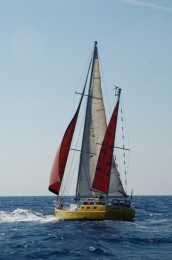
The hurricane season runs from June through to mid-November, meaning that, in theory, one can safely set off from Europe across the Atlantic in autumn and spend from Christmas through till mid-May cruising amongst the islands. Generally speaking, however, the tradewinds do not return to the region and provide for a good crossing until January or February.
Having left it until February to cross, and having made a slow passage (the trades having failed, this year, to play by the book) we landed in the Caribbean with barely enough time to do justice to even a couple of sun-soaked isles. To be exact, when Mollymawk and Cherub sailed into Hillsborough after three weeks at sea, we had precisely two and a half months in which to explore a cruising ground which might have kept us happy for several years.
With only ten weeks at our disposal we did not have the time to pay even a fleeting vist to each and every island in the chain, and so we sat down and – for the first time in our cruising career – we made a plan. First we listed the islands which we wanted to visit. Then we calculated the time it would take us to sail from each one to the next. These figures having been added together and then deducted from the total quota, we were left with a period of seven weeks “shore leave”. This time ashore was subsequently divided up amongst the chosen islands.
The Master Plan
Carriacou had been chosen as the starting point for our tour, partly because we had never been here before but largely because it was one of Cherub‘s various home ports. It was in Carriacou that Johnson’s youngest son was born, and here he had many friends, both ashore and afloat, who would be eager to see him again.
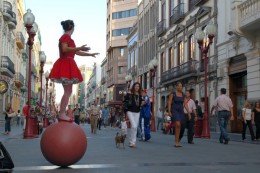
Martinique was a late addition to the itinerary. We had no particular interest in visiting this populous and thoroughly Westernised isle until we learnt that our good friends Gigi and Marie were plying their trade in Saint Pierre. The chance to enjoy another night of laughter and song was too good to miss and so we decided to allow ourselves just two nights here.
Next on the list was Dominica, with its lush forests and waterfalls, and after that came Antigua.
It was in Antigua that Caesar and Xoë joined ship, 19 and 17 years ago respectively. Having spent more than two years living and working in the island Nick and I had many friends here – although whether any of them would still remember us, 17 years on, was another matter.
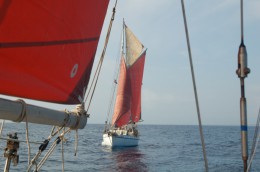
From Antigua we planned to hop across to Nevis where lived Captain Johnson’s bosom buddies – friends of almost 40 years standing – together with several other acquaintances. Yes, as we drew up the list we realised that our Caribbean tour was destined to degenerate into a series of nostalgic dinner parties…
But after Nevis we would be on our own. From that island we would sail to Saba – which is a place that I have always wanted to visit – and then we would cease this island-hopping game and go north and west, without stopping, until we reached Cuba.
Cuba. The kids may have come to the Caribbean to see their homeland, but so far as I was concerned, Cuba was our principal destination. For 20 years I had been wanting to visit this extraordinary land with its fabulous history of survival against all the odds. With Fidel now having one foot in the grave, this looked like being our last chance before the place comes tumbling down.
By the time we got round to finalising our itinerary we had already spent four days in Carriacou – and by the time we left we were already two days behind with the schedule.
Wind and Current
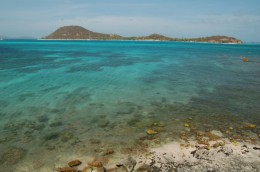
Carriacou is legally wedded to Grenada, but the locals resent this marriage, in a quiet sort of a way. The union was forced upon them by their foster parent when she tired of handing out their allowance and cast them out of the Great British Empire; but the locals feel themelves and their isle to be a part of the Grenadines – and the Grenadines belong to St Vincent.
One has only to glance at the chart to see that St Vincent and the Grenadines are a marvellous playground for yotties – but our tight schedule did not allow us to stop at even one island; we must hurry on by. Whilst Cherub took the inside route, passing to leeward of the group, we preferred to make full use of the tradewind blowing onto their eastern shores. Leaving Windward as soon as the sun was high enough to show us the reefs, we beat out – past the shoals, and past Petit Martinique – into the Atlantic.
The wind was blowing a steady force five and the blue sea was flecked with white caps. The current flowing under the tradewind was very strong and although we stood out for a couple of miles, when we eventually tacked we found that we still needed to keep on the wind in order to clear the islands. Indeed, we found ourselves crabbing along; we were close-hauled and heading out to sea, but we were being simultaneously pushed north-west.
The current was flowing onto the wave-swept shores at three knots, but in the gaps between the islands it ran at as much as five knots.
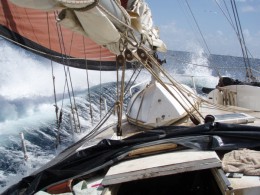
By the time we arrived at St Lucia the current had ferried us so far shorewards that we had no hope of clearing the island without tacking, and so we decided to duck inside, through the channel, and leave it to windward. The wind and current behind the island were both very much weaker – as was only to be expected – and our progress now became correspondingly slower.
We eventually arrived off St Pierre at about three o’clock on the afternoon of our second day at sea. Cherub, having taken the quieter, inside route for the entire journey, arrived at 22:00.
Saint Pierre (Martinique)
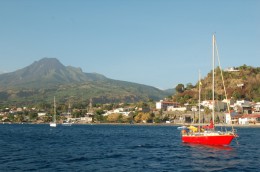
Saint Pierre is a small but very busy town situated in the north-western part of Martinique. The approach is straightforward – there are no offlying islets or shoals – and the anchorage is simply a roadstead.
Most folk drop their hook in the vicinity of the pier, at the northern end of the settlement. This makes for an easy row ashore, but it is not necessarily the best spot; the water here is 15 to 20 metres deep whereas further south, off the beach, it is only 6 or 8 metres deep. However, landing on the beach can be exciting (ie. wet) even in calm conditions. When the swell is up it would be more fun than white water rafting.
Don’t be tempted to leave your yacht on one of the buoys which sit in the deeper water at the edge of the anchorage. These are not moorings.
Yachtsmen leaving their dinghies on the pier should remember to use a stern anchor. We saw two dinghies damaged when they were trapped under the pier by the rising tide; two dinghies damaged and one outboard motor swamped.
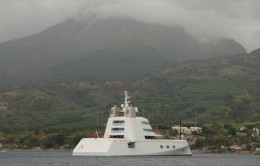
Martinique is part of France and so the enrty procedure here is as relaxed as it would be on the other side of the pond, in Europe. Formalities are completed in a bar which stands just across the road from the beach, a short distance south of the pier. There are no officials waiting here to receive the new arrival; one simply taps the required information into a computer.
The same bar also has a wifi service, but it is very expensive and we were unable to pick it up from the boat even though we anchored as close as was possible.
French colonies, the world over, have the reputation for being very expensive, and thus we were suprised to find that the cost of vegetables and other groceries was actually less in Martinique than in Carriacou. (Nevis proved to be by far the most expensive place on our itinerary in which to buy food. Antigua was no cheaper than Carriacou, but there was a much wider selection of produce available.)
Tinned goods, biscuits, and such like cost little more in Martinique than they do in Spain or the Canary Islands. Wine was also affordable here – although it has to be said that very cheap French wine is not a patch on very cheap Spanish wine. We were very glad that we still had a few bottles of Rioja in our bilge.
A small vegetable market sited at the root of the pier provides a reasonable selection of good quality vegetables and fruit, but people not accustomed to shopping in the tropics may find that tomatoes, bananas, and green peppers are the only familiar items. The supermarket too had a couple of surprises: we were distressed to see turtle meat in the frozen food cabinet – in a country with a European government! – but the shock of finding the flesh of endangered animals on sale was overshadowed when we came across a bucket of pig’s penises and another containing frozen testicles. As if brawn and trotters weren’t bad enough!
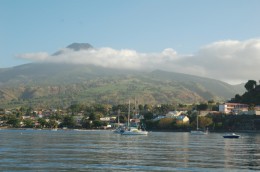
Saint Pierre used to be the capital of Martinique until the lofty mountain to the north suddenly split its sides, one day in 1902, and knocked the place flat. Accounts of the Mt Pelee disaster include reports made by various seamen whose ships happened to be anchored off the town that morning. The biggest of these vessels was the 340ft steamship Roraima. She arrived only an hour or so before the eruption and her purser desribed how, during their approach, the mountain had been providing the greatest firework show on earth: “The spectacle was magnificent. As we approached St Pierre we could distinguish the rolling and leaping of the red flames that belched from the mountain in huge volumes and gushed into the sky. … The flames were spurting straight up in the air, now and then waving from side to side for a moment. … There was a constant muffled roar.”
Oddly enough, nobody seemed to find this show the least bit threatening. Ashore, those people who were not standing around idly watching the display were going about their usual business. And then, all of a sudden, “there was a tremendous explosion and the mountain was blown to pieces.” According to our friend the purser, “There was no warning.”
Heck! How much warning does a volcano have to give of its intentions!
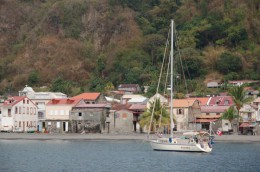
The shock wave associated with the eruption surged outward like the ripples from a stone dropped in a puddle – but with proportionately greater efect: “The side of the volcano was ripped out and there was hurled straight towards us a solid wall of flame. It sounded like a thousand cannon.”
The fire struck St. Pierre with the speed of lightning. The town vanished from the sight of those aboard the various ships, anchored just a couple of hundred yards away; and in that instant the buildings all fell down and almost 30,000 people died. Those few souls who survived the initial blast were scarcely to be thought of as the lucky ones, for while they ran around, with their clothes and hair on fire, the volcano belched out a cloud of poisonous fumes – and that was that. “Afterwards not one living being was seen on land.”
Nor was the town the only thing to suffer as a result of the cataclysmic explosion. The shock wave and the wall of fire also swept over the anchorage. 18 ocean-going ships are thought to have been capsized by the blast and to have sunk with all hands. Roraima was one of the few vessels which did not immediately go to the bottom – but she was certainly not untouched; far from it. According to the purser, “Wherever the fire struck the sea, the water boiled and sent up vast clouds of steam. The sea was torn by huge whirlpools (and) one of these… swung under Roraima and sucked her down on her beam ends. … The fire swept off the masts and smokestacks as if they were cut with a knife.”
Another survivor said that one of the most terrifying things about the ordeal was that it took place in the dark. “The sun was completely obscured by the ashes from the volcano, and the only light came from the burning town and the ships.”
Aside from the purser, Roraima‘s captain was the only person on deck not to be killed instantly by the first blast – and he was horribly burned. As the ship righted herself she was suddenly hit by another wall of fire which sent her careening the other way, and this time the captain fell overboard from the bridge, never to be seen again. Of the 68 crew and passengers, only 25 survived. These men and women happened to be down below during the inferno but managed to reach the deck and get away in the lifeboats before the ship eventually sank.
Roraima still lies there on the seabed, along with half a dozen other casualties of the eruption. In fact, these wrecks fringe the edge of the anchorage. Yes, that‘s what the buoys are for; effectively, they are gravestones!
Scuba divers can descend to take a look at the remains of the various vessels, but for some of us the knowledge that they are down there, just below us, is quite spooky enough.
The only vessel which managed to escape from the Mt. Pelee maelstrom was Roddam; another British steamship of around 300ft in length. Roddam had hardly set her anchor when the mountain exploded, and her captain, although badly injured by the initial blast, propmtly did the only sane thing: he mustered his surviving crew members and gave the order to slip the anchor and flee. Even so, there was so much debris in the water, and so much damage had been done to the ship, that it took her two hours to clear the bay. And by that time the show was over.
Roddam made it to the neighbouring island of St Lucia where her captain, as he was helped ashore, said, “I have come from Hell.”
Drop by next week for Part II of this article.
